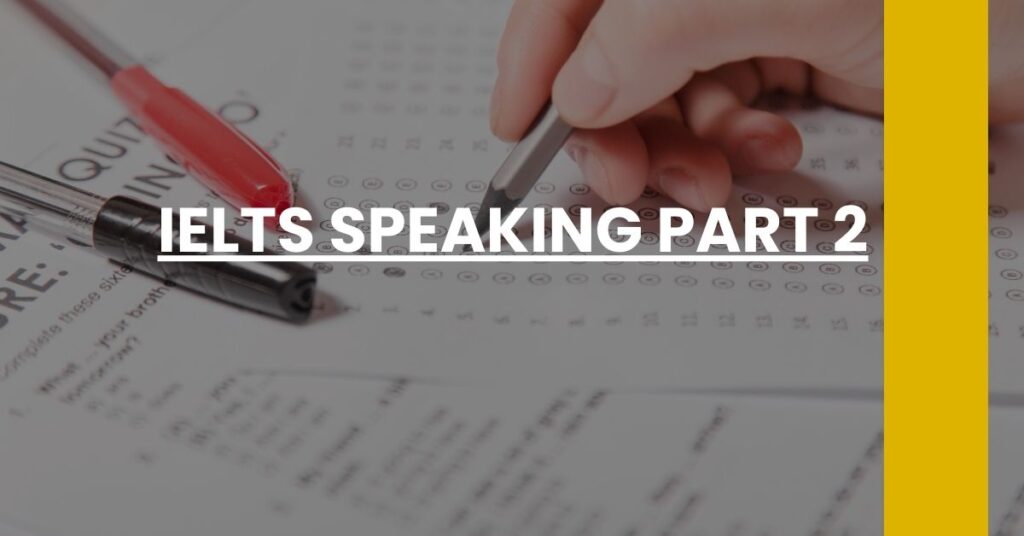IELTS Speaking Part 2 mastery makes a significant difference in your overall IELTS score.
- Effective Strategies for IELTS Speaking Part 2: Learn to organize your thoughts in a logical flow.
- Practice Techniques for IELTS Speaking Part 2: Enhance fluency and reduce hesitation with targeted exercises.
- Understanding IELTS Speaking Part 2 Criteria: Familiarize yourself with what examiners are looking for.
Gain confidence in IELTS Speaking Part 2 with these focused insights.
- Understanding IELTS Speaking Part 2
- The IELTS Speaking Part 2 Cue Card
- Key Strategies for Responding to Cue Card Topics
- Common IELTS Speaking Part 2 Topics
- Practicing for Fluency and Coherence
- Vocabulary and Grammar for IELTS Speaking Part 2
- Time Management During the Test
- Dealing with Nerves and Hesitation
- Mock Test Practices
- Review and Feedback
- Conclusion: The Path to IELTS Speaking Success
Understanding IELTS Speaking Part 2
When you set your sights on achieving a high band score in the IELTS, mastering each component of the exam becomes a priority. IELTS Speaking Part 2 is no exception; it’s your opportunity to impress the examiner with your fluency and expressiveness, without the aid of back-and-forth conversation found in other parts of the speaking test.
In this section, you’re given a task card with a specific topic — often a personal experience or opinion. You’ll have just one minute for brainstorming and note-taking before diving into a two-minute monologue. While this might sound daunting, it’s really an invitation to showcase your ability to organize thoughts coherently and deliver them with confidence.
What to Expect During Your Test
- Topic Cards: Topics span a broad range of subjects but usually hover around everyday experiences and thoughts. You might be asked to describe an event, a person important to you, or even a favorite book.
- Preparation Time: You have 60 critical seconds to jot down notes that will guide your monologue.
- Speech Duration: You need to speak for 1-2 minutes, a timeframe that seems brief but requires thoughtful content planning.
Succeeding here hinges on your ability to maintain a natural flow of speech while effectively managing your allotted time. Let’s delve deeper into strategies that can elevate your speaking performance to new heights.
The IELTS Speaking Part 2 Cue Card
Now, let’s dissect the cue card, which is essentially your roadmap for the speaking journey ahead. Each card features a main prompt, followed by sub-questions or bullet points intended to inspire a fuller response.
Efficient Use of Preparation Time
- Analyze the Prompt: Quickly discern the central theme of the task.
- Structure your Notes: Organize your thoughts using simple keywords or phrases that can trigger more elaborate ideas during your speech.
- Balance Breadth and Depth: Ensure you cover all aspects of the prompt while preparing to add details that enrich your narrative.
Remember, the aim here is to use your minute wisely to create a blueprint for your speech which, when utilized effectively, serves as a stepping-stone to a compelling delivery.
Key Strategies for Responding to Cue Card Topics
Your ability to respond to the cue card topics with clarity and relevance can significantly impact your IELTS speaking band score. But don’t worry; with the right strategy, you can navigate this seamlessly.
Crafting a Logical Narrative
- Open Strongly: Begin with a clear and direct response to the prompt to immediately demonstrate topic understanding.
- Storytelling: Turn your experiences or opinions into stories with a beginning, middle, and end to captivate your listener.
- Stay on Topic: Keep your notes visible and use them as anchors to your speech to prevent digression.
Remember, the clarity of your response and your ability to remain relevant throughout are key to achieving a high score in IELTS Speaking Part 2.
Common IELTS Speaking Part 2 Topics
It’s essential to familiarize yourself with the kinds of themes you might encounter in IELTS Speaking Part 2. These prompts are your stage for illustration, not just with words, but through the tone, emotion, and nuance you can express.
Frequently Encountered Themes and Examples
- People and Relationships: You might describe a friend, a family member, or a mentor, reflecting on the nature of your relationship.
- Places: This could involve talking about a memorable visit, a dream destination, or even the town where you grew up.
- Events and Experiences: From important life events to everyday activities, this theme requests a cohesive narrative about past experiences.
Developing responses to these commonly seen topics arms you with the ability to pivot during the test, no matter the prompt you’re presented with. More importantly, as you practice, you’ll find your own voice and storytelling style within the IELTS parameter.
Practicing for Fluency and Coherence
Fluency isn’t about speed; it’s about control and the smooth progression of your language. Coherence, meanwhile, is about making sure your ideas connect in a logical and understandable manner. Together, these are the pillars of effective communication in IELTS Speaking Part 2.
Exercises and Methods to Enhance Your Speaking
- Simulated Practice: Regularly record yourself answering various cue cards to analyze and improve from your trials.
- Language Function Focus: Practice making comparisons, expressing opinions, or speculating, as these are common tasks in IELTS prompts.
- Conversation Practice: Engaging in English conversations on a range of topics can dramatically improve your reactive speaking skills.
Remember, every moment you speak English is a step toward more fluent, more coherent communication. Treat every word as an opportunity and every sentence as progress toward your goal.
Vocabulary and Grammar for IELTS Speaking Part 2
In IELTS Speaking Part 2, the richness of your vocabulary and the accuracy of your grammar are not just display cases for your language ability; they are the very tools with which you construct responses that resonate with clarity and sophistication.
Expanding Your Lexical Resource
- Synonyms and Paraphrasing: Immerse yourself in English literature, films, and conversations to pick up varied ways of expressing similar ideas. This will not only bolster your vocabulary but also help you avoid repetition.
- Contextual Learning: Understand the nuanced meanings of words within different contexts. Using words appropriately in sentences will showcase your grasp of the language beyond memorization.
- Idiomatic Language: Although the use of idioms can enrich your speech, ensure they are pertinent and that you are confident in their usage to avoid potential misunderstandings.
Grammar Groundwork
- Tense Mastery: Your ability to switch tenses appropriately demonstrates linguistic agility—practice narrating past events, discussing current habits, and expressing future aspirations.
- Complex Sentences: Incorporate subordinate clauses and a variety of conjunctions to show the depth of your grammatical understanding.
- Self-Correction: If you make an error, briefly correct it and move on. This shows the examiner that you can self-monitor your language use.
Enhancing vocabulary and perfecting grammar are ongoing journeys—the more you immerse yourself in the language, the more natural and effective your communication will become.
Time Management During the Test
Time management in IELTS Speaking Part 2 is about precision and pacing. Your one-minute preparation and two-minute speaking time are your golden minutes—here’s how to leverage them to your advantage.
Tips for Effective Time Management
- Outline Quickly: Spend your initial preparation seconds outlining your speech’s structure—introduction, key points, and conclusion—to avoid meandering during your monologue.
- Depth Over Breadth: Rather than skimming over many points, choose a few to discuss in detail. This allows for a more enriched and involved narrative within the time constraints.
- Pace Your Speech: While speaking, be conscious of pacing—not too hurried to seem rushed, and not too slow to risk underutilizing your time.
Managing time effectively during the IELTS Speaking Part 2 ensures that you can showcase the breadth of your abilities without being cut off mid-sentence.
Dealing with Nerves and Hesitation
Staying composed during IELTS Speaking Part 2 might be challenging, but it’s also within your control. It’s about channeling nervous energy into a performance that feels both rehearsed and authentic.
Strategies for Mitigating Speaking Anxiety
- Breathing Techniques: A few deep breaths before speaking can calm nerves and ground your thoughts.
- Positive Visualization: Imagine a successful speech outcome to foster confidence and reduce the fear of negative evaluation.
- Speak Slowly: This gives you time to think and minimizes the chances of your nerves causing rapid, unclear speech.
Remember, it’s natural to feel trepidation when taking an important test like the IELTS. Accepting the nerves as part of the experience and preparing for them can help you maintain control over your performance.
Mock Test Practices
Replicating test conditions with mock tests can substantially boost your readiness for IELTS Speaking Part 2. It’s about making the test environment feel familiar so that, when the real moment comes, you’re well-acquainted with the landscape.
The Role of Mock Tests in Preparation
- Simulate the Test Environment: Create a test-like atmosphere to help you adapt to the pressure and timing of the real exam.
- Recording Your Responses: Listen back to identify patterns, hesitations, and areas for improvement.
- Feedback Loop: Have teachers or peers provide constructive criticism to fine-tune your speaking abilities.
The closer your practice conditions are to the actual test environment, the more comfortable you’ll feel when taking IELTS Speaking Part 2.
Review and Feedback
Reflective practice through review and feedback is an invaluable part of excelling in IELTS Speaking Part 2. It’s not only about practicing but also about understanding the impact of your practice and refining your approach accordingly.
Continuous Self-Improvement:
- Analyze performances for areas needing improvement.
- Act on feedback to make incremental changes to your speaking style.
- Celebrate progress as a motivator for ongoing effort.
Embrace reviews and feedback as opportunities for growth rather than criticism—every piece of advice is a step towards a more polished performance.
Conclusion: The Path to IELTS Speaking Success
Your journey to conquering IELTS Speaking Part 2 is paved with consistent practice, strategy, and self-awareness. Each step of preparation—from enhancing vocabulary to managing anxiety—is a cornerstone in building the resilience and skills necessary to excel.
Remember, your objective in IELTS Speaking Part 2 is to communicate effectively and demonstrate the depth of your English proficiency. Keep your goals insight, practice diligently, and approach the test with the confidence that comes from being well-prepared. You have the tools and strategies at your disposal—your success in IELTS Speaking Part 2 is within reach.
IELTS Speaking Part 2 mastery guide: Strategies, practice tips, and assessment criteria insights to ace your exam.

